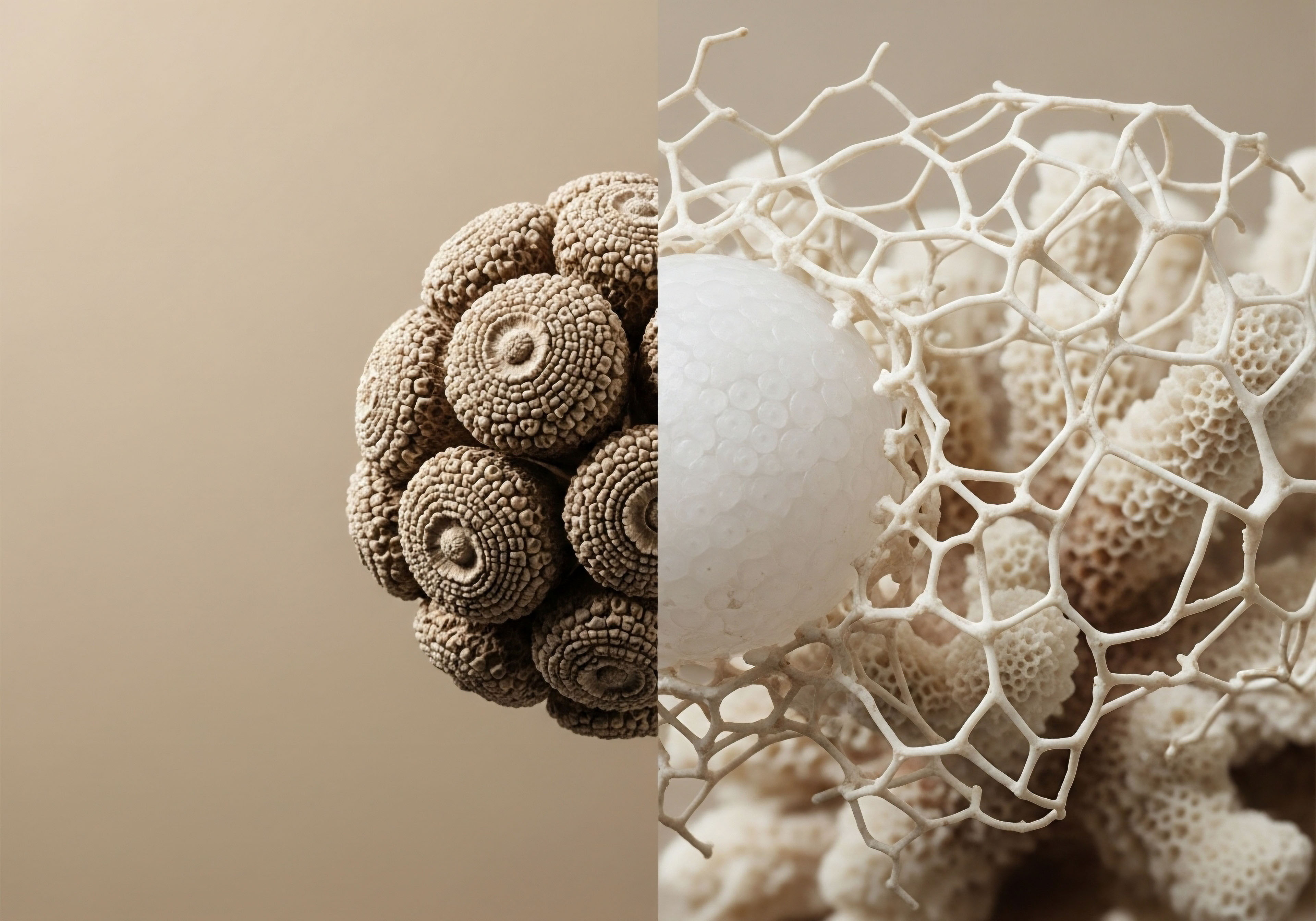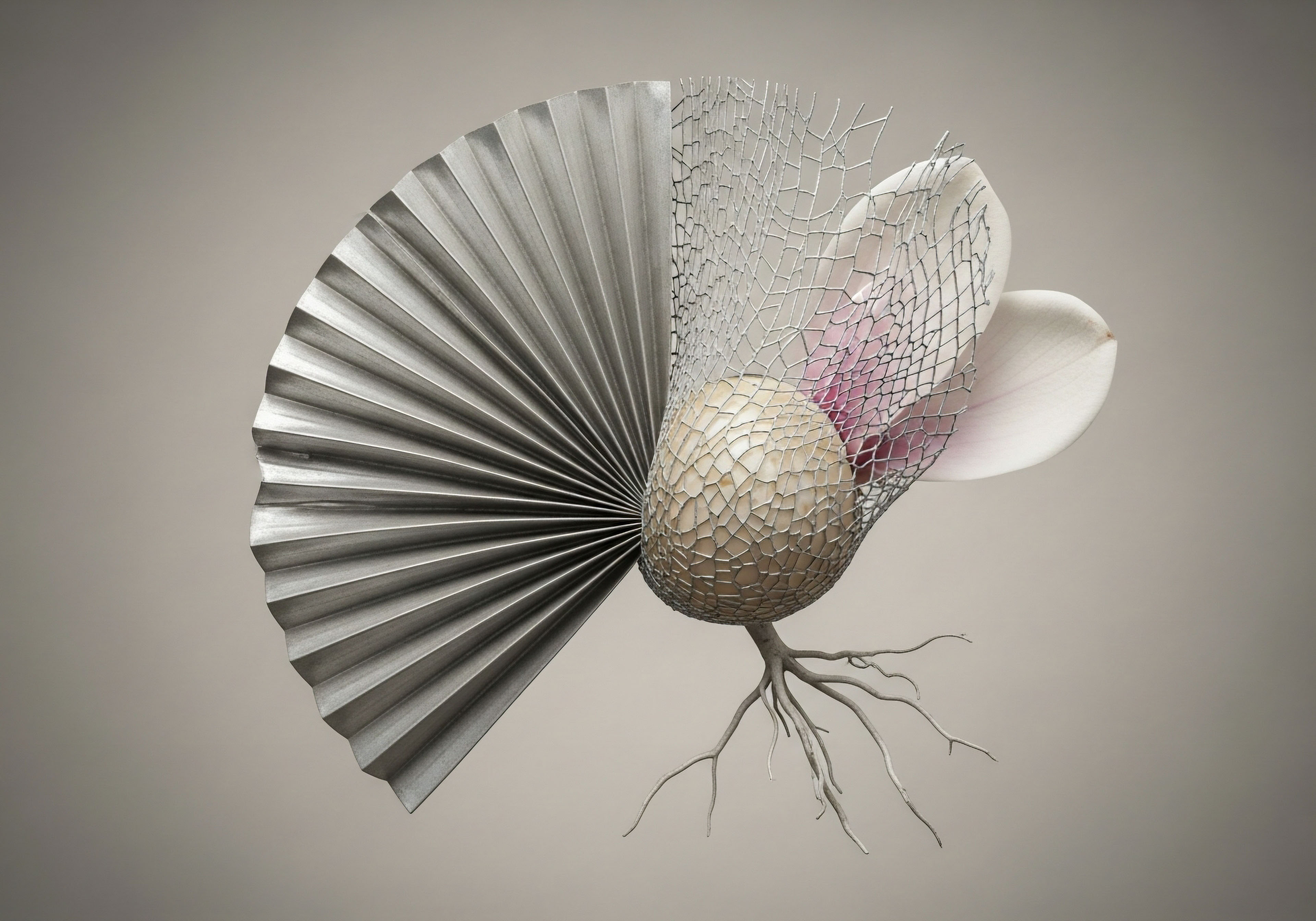

Fundamentals
The decision to begin testosterone replacement therapy (TRT) often comes from a deep-seated desire to reclaim a sense of vitality, strength, and well-being that has diminished over time. It is a proactive step toward optimizing your body’s systems. Subsequently, the choice to pause or conclude that therapy to pursue building a family represents another profound life decision.
This transition, from hormonal support to a fertility-focused protocol, brings its own set of biological questions. You may be wondering how to best support your body’s natural processes as they come back online. The conversation about this recalibration often centers on pharmacology ∞ medications like Gonadorelin or Clomid designed to restart the body’s own signaling.
A foundational component of this process, the nutritional environment you create, is equally significant. The foods you consume provide the raw materials and energetic currency for every single hormonal process in your body.
At the heart of this entire system is a sophisticated communication network known as the Hypothalamic-Pituitary-Gonadal (HPG) axis. Think of it as the body’s internal thermostat for reproductive health. The hypothalamus in the brain releases Gonadotropin-Releasing Hormone (GnRH) in carefully timed pulses.
This signal travels to the pituitary gland, prompting it to release Luteinizing Hormone (LH) and Follicle-Stimulating Hormone (FSH). LH then signals the Leydig cells in the testes to produce testosterone, while FSH is a primary driver of spermatogenesis, the process of creating sperm, within the Sertoli cells.
When you introduce testosterone from an external source during TRT, the brain senses that levels are sufficient and dials down its own GnRH, LH, and FSH production. This is a natural and expected feedback loop. The goal of a post-TRT fertility protocol is to gently and effectively turn that system back up.
Your diet provides the essential building blocks and energy that fuel the entire hormonal cascade required for fertility.

The Role of Macronutrients as Biological Signals
Your daily intake of protein, fats, and carbohydrates ∞ the three macronutrients ∞ does much more than provide calories. Each macronutrient class has a distinct and direct influence on the hormones that govern fertility. They are not just fuel; they are signaling molecules that can either support or hinder the delicate process of restarting the HPG axis. Understanding their roles provides a powerful tool for creating an internal environment conducive to restoring natural function.

Fats the Precursors to Hormones
Steroid hormones, including testosterone, are synthesized from cholesterol. This makes dietary fat, the source of cholesterol and essential fatty acids, a non-negotiable component of a fertility-supporting diet. The structure of every Leydig cell and Sertoli cell in the testes is built from lipids.
The very membranes that allow these cells to receive signals from LH and FSH are composed of fats. A diet severely deficient in healthy fats can deprive the body of the fundamental building blocks needed to construct the hormones central to reproduction. Different types of fats, such as monounsaturated, polyunsaturated (including omega-3s), and saturated fats, all play distinct roles in cellular health and inflammatory processes, which can indirectly affect testicular function.

Proteins the Foundation of Structure and Function
Proteins are assembled from amino acids, which are the workhorses of the body. They form enzymes that catalyze hormonal conversions, build cellular receptors that receive hormonal messages, and constitute the physical structure of sperm cells themselves. For instance, protamines, which are crucial for compacting DNA tightly within the sperm head, are proteins.
Inadequate protein intake can lead to a deficiency in the specific amino acids required for efficient spermatogenesis, potentially affecting sperm count, motility, and morphology. A diet sufficient in high-quality protein ensures the testes have the necessary materials to build healthy, functional sperm as the FSH signal begins to rise.

Carbohydrates the Body’s Primary Energy Source
Carbohydrates are the body’s preferred source of energy. The process of spermatogenesis is incredibly energy-intensive. Without sufficient energy, cellular processes can slow down. However, the type and quantity of carbohydrates consumed have a profound impact on the hormone insulin.
Chronic consumption of highly processed, high-glycemic carbohydrates can lead to insulin resistance, a state where the body’s cells do not respond efficiently to insulin’s signal to take up glucose from the blood. This condition is closely linked to hormonal disruption.
Insulin resistance can interfere with the pulsatile release of GnRH from the hypothalamus, creating an unstable foundation for the entire HPG axis. Therefore, managing carbohydrate intake to maintain stable blood sugar and good insulin sensitivity is a cornerstone of supporting fertility.
By viewing macronutrients through this lens ∞ as active participants in your body’s endocrine dialogue ∞ you can begin to make informed choices that align with your goal of restoring fertility. The objective is to create a robust, stable, and well-supplied biological environment where the pharmacological interventions of your fertility protocol can work most effectively.


Intermediate
Transitioning from testosterone therapy to a fertility protocol involves a carefully orchestrated biological handover. While medications like hCG, clomiphene citrate, or tamoxifen are prescribed to directly stimulate the HPG axis, the metabolic environment in which these signals are received is profoundly shaped by your macronutrient intake.
The effectiveness of these protocols can be significantly influenced by the body’s underlying metabolic state, particularly its sensitivity to insulin and the availability of specific substrates for hormone synthesis and cellular function. A targeted nutritional strategy works in concert with medical interventions, preparing the body to respond optimally.

Insulin Sensitivity the Metabolic Lynchpin
Insulin is most commonly associated with blood sugar regulation, but its influence extends deep into the reproductive endocrine system. Insulin resistance, a condition where cells become less responsive to insulin’s effects, creates a state of metabolic disruption that can directly undermine fertility efforts. Chronic high insulin levels, often a consequence of a diet high in refined carbohydrates and sugars, can negatively affect the HPG axis in several ways.
- Disruption of GnRH Pulsatility ∞ The hypothalamus releases GnRH in a rhythmic, pulsatile manner. This rhythm is essential for proper pituitary function. High levels of insulin and the associated inflammation can interfere with this delicate pulse generation, leading to erratic or suppressed LH and FSH signals.
- Impact on SHBG ∞ Insulin has a suppressive effect on the liver’s production of Sex Hormone-Binding Globulin (SHBG). SHBG is a protein that binds to testosterone in the bloodstream. Lower SHBG means more free testosterone is available to be converted into estradiol by the aromatase enzyme, particularly in adipose tissue. Elevated estradiol can then exert a stronger negative feedback on the hypothalamus and pituitary, further suppressing LH and FSH production ∞ the very hormones a fertility protocol aims to increase.
- Direct Testicular Effects ∞ Emerging research suggests that the testes themselves have insulin receptors. Insulin resistance may directly impair the function of Leydig cells (which produce testosterone) and Sertoli cells (which support sperm development), making them less responsive to the incoming LH and FSH signals your protocol is trying to generate.
Therefore, a primary nutritional goal during a post-TRT fertility protocol is to improve or maintain excellent insulin sensitivity. This is achieved by managing the glycemic load of the diet. Prioritizing complex, fiber-rich carbohydrates from vegetables, legumes, and some whole grains over simple sugars and refined starches helps to prevent sharp spikes in blood glucose and insulin. Pairing carbohydrates with protein and healthy fats further blunts the glycemic response, promoting a more stable hormonal environment.
Managing insulin through diet is a powerful lever for optimizing the entire hormonal axis.

Macronutrient Ratios a Framework for Endocrine Support
There is no single “magic” macronutrient ratio that guarantees success for every individual. However, understanding how different dietary frameworks influence the key hormonal players allows for a personalized and strategic approach. The goal is to provide the necessary building blocks for hormone production while fostering a state of metabolic calm.

Table Comparing Dietary Approaches for Fertility Support
| Dietary Approach | Macronutrient Focus | Mechanism of Action for Fertility | Potential Considerations |
|---|---|---|---|
| Modified Mediterranean | High in monounsaturated fats (olive oil, nuts), moderate protein (fish, poultry), complex carbs (vegetables, legumes). | Provides ample fatty acids for hormone synthesis. Low glycemic load supports insulin sensitivity. High in antioxidants, which protect sperm from oxidative damage. | A well-balanced and sustainable approach for most individuals. Focus should be on fatty fish for omega-3s. |
| Low-Glycemic / Carbohydrate-Managed | Protein and fats are prioritized. Carbohydrate sources are limited to low-glycemic index foods (non-starchy vegetables, berries). | Directly targets insulin resistance by minimizing glucose and insulin spikes. This can help normalize GnRH pulsatility and SHBG levels. | Highly effective for individuals with pre-existing insulin resistance or metabolic syndrome. Requires careful planning to ensure adequate micronutrient intake. |
| Higher Protein | Protein intake is elevated (e.g. 25-35% of total calories), with moderate fat and carbohydrate intake. | Supplies abundant amino acids for spermatogenesis and enzyme production. Protein has a high thermic effect and promotes satiety, aiding in body composition management. Some studies suggest a higher protein-to-carb ratio may support LH and FSH levels. | Source quality is paramount (lean meats, fish, eggs, legumes). Extremely high protein intake at the expense of other macros is not advisable. |

What Is the Best Source of Dietary Fat for Hormone Production?
While all fats provide energy, their molecular structure dictates their biological role. For supporting fertility, a focus on specific types of fats is beneficial.
- Monounsaturated Fats (MUFAs) ∞ Found in olive oil, avocados, and almonds, MUFAs are excellent for overall metabolic health and form a core component of anti-inflammatory dietary patterns like the Mediterranean diet.
- Polyunsaturated Fats (PUFAs) ∞ This category includes both omega-6 and omega-3 fatty acids. While some omega-6 is necessary, modern diets are often excessively high in it (from vegetable oils), which can be pro-inflammatory. Increasing intake of omega-3 fatty acids (from fatty fish like salmon, sardines, and mackerel, as well as walnuts and flaxseeds) is critical. Omega-3s are incorporated into sperm cell membranes, influencing their fluidity and function, and are precursors to anti-inflammatory molecules.
- Saturated Fats (SFAs) ∞ Found in animal products and coconut oil, SFAs are necessary for health and provide cholesterol, the direct precursor to testosterone. However, excessive intake, particularly from processed meats and in the context of a high-sugar diet, has been associated with impaired sperm quality. The key is balance and sourcing from high-quality, whole foods.
A strategic approach to nutrition during a post-TRT fertility protocol involves more than just counting calories. It requires a conscious effort to manage insulin signaling through smart carbohydrate choices, provide a rich supply of hormone-building fats, and ensure an adequate intake of protein for cellular construction. This metabolic optimization creates a fertile ground upon which pharmacological interventions can build, supporting the body’s return to its natural rhythm.


Academic
The successful re-initiation of spermatogenesis following the cessation of exogenous testosterone administration is a complex physiological process, contingent upon the functional integrity of the entire HPG axis. Pharmacological interventions with agents such as human chorionic gonadotropin (hCG), clomiphene citrate, and tamoxifen are designed to restore endogenous gonadotropin secretion and intratesticular testosterone production.
However, the cellular machinery responsible for responding to these stimuli ∞ the Leydig and Sertoli cells ∞ operates within a metabolic milieu profoundly influenced by systemic nutritional status. A granular examination of how macronutrient composition modulates intracellular signaling pathways, gene expression, and metabolic efficiency within the testicular microenvironment reveals a critical role for diet as an adjunctive therapeutic strategy.

Molecular Interplay between Insulin Signaling and Testicular Function
The association between insulin resistance and male hypogonadism is well-documented. From a molecular standpoint, this connection extends beyond the central disruption of GnRH pulsatility. The testicular cells themselves are direct targets for insulin action, and their sensitivity to this hormone is a determinant of their steroidogenic and spermatogenic capacity.
Leydig cells possess insulin receptors (INSRs). Insulin signaling, via the PI3K/Akt pathway, potentiates LH-stimulated testosterone production. It does this by upregulating the expression of key steroidogenic enzymes, including the Steroidogenic Acute Regulatory (StAR) protein, which facilitates the rate-limiting step of cholesterol transport into the mitochondria, and P450scc (cholesterol side-chain cleavage enzyme).
In a state of systemic insulin resistance, characterized by hyperinsulinemia, testicular cells can develop a localized insulin resistance. This results in a downregulation of INSRs and a blunted response to both insulin and, consequently, to LH. Therefore, even as a fertility protocol successfully elevates LH levels, the Leydig cells’ ability to respond by synthesizing testosterone may be compromised in an insulin-resistant state.
Sertoli cells, the “nurse” cells of spermatogenesis, are also insulin-sensitive. They are responsible for providing structural and nutritional support to developing germ cells. Insulin signaling in Sertoli cells is crucial for glucose uptake and lactate production. Germ cells, particularly spermatocytes and spermatids, have a limited capacity for glucose metabolism and rely on Sertoli-derived lactate as their primary energy substrate.
Impaired insulin sensitivity in Sertoli cells can lead to a state of localized energy deprivation for developing sperm, potentially causing maturation arrest and apoptosis, thereby reducing sperm quality and count irrespective of FSH levels.
The metabolic health of testicular cells is a direct predictor of their response to hormonal stimulation.

How Do Specific Fatty Acids Modulate Cellular Processes in the Testes?
The lipid composition of testicular cell membranes is not merely structural; it is a dynamic factor that influences receptor function and intracellular signaling. The balance between different classes of fatty acids in the diet directly translates to the fatty acid profile of these membranes.
- Docosahexaenoic Acid (DHA) ∞ This omega-3 polyunsaturated fatty acid is uniquely concentrated in the testes and sperm. DHA is essential for the biogenesis of the acrosome, the cap-like structure on the sperm head containing enzymes necessary for fertilization. It also contributes to the extreme fluidity of the sperm tail membrane, which is critical for motility. A diet deficient in DHA can lead to the production of sperm with poor motility and abnormal morphology, specifically with defects in the acrosome.
- Arachidonic Acid (ARA) ∞ This omega-6 polyunsaturated fatty acid is the precursor to series-2 prostaglandins (e.g. PGE2) and series-4 leukotrienes, which are potent pro-inflammatory mediators. While some inflammation is necessary for normal tissue remodeling, chronic low-grade inflammation driven by an excessive ARA-to-DHA ratio can be detrimental to the testicular environment. This inflammatory state can increase oxidative stress, damaging sperm DNA and impairing Leydig cell function.
- Saturated Fatty Acids (SFAs) ∞ High concentrations of certain SFAs, like palmitic acid, in the context of a hypercaloric diet, have been shown to induce lipotoxicity in Leydig cells. This process involves the generation of reactive oxygen species (ROS) and endoplasmic reticulum stress, leading to cellular apoptosis and reduced testosterone output.
A dietary strategy that emphasizes a higher intake of omega-3s relative to omega-6s, and sources saturated fats from whole foods within a normocaloric diet, can therefore optimize membrane composition and reduce the inflammatory tone within the testes, creating a more favorable environment for spermatogenesis.

Table of Macronutrient-Related Cofactors in Spermatogenesis
| Nutrient/Cofactor | Primary Macronutrient Source | Biochemical Role in Fertility | Clinical Significance |
|---|---|---|---|
| L-Carnitine & Acetyl-L-Carnitine | Primarily from red meat (protein); also synthesized endogenously. | Essential for the transport of long-chain fatty acids into the mitochondria for beta-oxidation. This is a primary energy source for sperm motility. | Supplementation has been shown in some studies to improve sperm motility and maturation. |
| L-Arginine | Protein sources (nuts, seeds, poultry, fish). | A precursor to nitric oxide (NO), which is involved in vasodilation and blood flow regulation. Also a precursor for polyamines (spermidine, spermine) involved in cell proliferation and DNA stabilization. | Adequate intake is necessary for testicular blood flow and the structural integrity of sperm DNA. |
| Coenzyme Q10 (CoQ10) | Fat sources (fatty fish, organ meats). | A vital component of the mitochondrial electron transport chain for ATP production. Also a potent lipid-soluble antioxidant, protecting cell membranes from peroxidation. | Higher concentrations in seminal fluid are correlated with better sperm count and motility. |
| Zinc | Protein sources (oysters, beef, pumpkin seeds). | A cofactor for over 300 enzymes, including those involved in testosterone synthesis and DNA/RNA polymerase. Essential for sperm chromatin condensation. | Deficiency is strongly linked to hypogonadism and impaired spermatogenesis. |
In conclusion, while post-TRT fertility protocols pharmacologically target the endocrine signaling cascade, the ultimate success of these treatments rests on the metabolic competency of the testes. A nutritional framework focused on optimizing insulin sensitivity through the management of dietary carbohydrates is paramount.
This foundation, combined with a lipid profile that favors anti-inflammatory omega-3 fatty acids and provides adequate cholesterol for steroidogenesis, alongside sufficient high-quality protein for essential amino acids and micronutrient cofactors, constitutes a robust, evidence-based strategy. This approach ensures the testicular machinery is fully equipped to respond to the restored hormonal signals, thereby maximizing the potential for a successful return of fertility.

References
- Skoracka, K. et al. “Diet and Nutritional Factors in Male (In)fertility ∞ Underestimated Factors.” Journal of Clinical Medicine, vol. 9, no. 5, 2020, p. 1400.
- La Vignera, S. et al. “Metabolic Disorders and Male Hypogonadotropic Hypogonadism.” Frontiers in Endocrinology, vol. 11, 2020, p. 593.
- Pitteloud, N. et al. “Increasing Insulin Resistance Is Associated with a Decrease in Leydig Cell Testosterone Secretion in Men.” The Journal of Clinical Endocrinology & Metabolism, vol. 90, no. 5, 2005, pp. 2636 ∞ 41.
- Nassan, F. L. et al. “Dietary Fat and Semen Quality Among Men Attending a Fertility Clinic.” Human Reproduction, vol. 32, no. 7, 2017, pp. 1418 ∞ 26.
- Cheah, Y. and W. Yang. “Functions of essential nutrition for high quality spermatogenesis.” Advances in Bioscience and Biotechnology, vol. 2, no. 4, 2011, pp. 182-197.
- Ajuogu, P. K. et al. “The effects of dietary protein deficiency on rat testicular function.” Andrologia, vol. 52, no. 9, 2020, e13735.
- Wenker, E. C. et al. “The Use of HCG-Based Combination Therapy for Recovery of Spermatogenesis after Testosterone Use.” Journal of Sexual Medicine, vol. 12, no. 6, 2015, pp. 1334-40.
- Corona, G. et al. “The Role of Diet and Weight Loss in Improving Secondary Hypogonadism in Men with Obesity with or without Type 2 Diabetes Mellitus.” Nutrients, vol. 12, no. 11, 2020, p. 3397.
- Ding, H. et al. “Effects of chronic exposure to a high fat diet, nutritive or non-nutritive sweeteners on hypothalamic-pituitary-adrenal (HPA) and -gonadal (HPG) axes of male Sprague-Dawley rats.” European Journal of Nutrition, 2024.
- Liu, C. Y. et al. “Age and Duration of Testosterone Therapy Predict Time to Return of Sperm Count after hCG Therapy.” Journal of Urology, vol. 199, no. 4S, 2018, e1034.

Reflection

Charting Your Path Forward
The information presented here offers a biological framework for understanding how your nutritional choices interface with your body’s intricate hormonal systems. You have seen how the energy and materials from your diet are not passive components but active contributors to the conversation happening between your brain and your testes.
This knowledge shifts the perspective from simply undergoing a protocol to actively participating in your own physiological restoration. The path to building a family is a profound one, and every system in your body is being called upon to support that goal.
Consider the daily act of eating as an opportunity to align your internal environment with your ultimate intention. Each meal can be a conscious choice to provide the specific resources your body needs to rebuild, recalibrate, and respond. This journey is uniquely yours, written in the language of your own biology.
The principles discussed provide a map, but the territory is your own body. Listening to its responses, observing changes in your energy and well-being, and working in partnership with your clinical team will guide you in tailoring these strategies to your specific needs. The power to influence this process resides on your plate, every single day.



